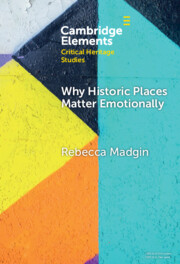Refine search
Actions for selected content:
677 results
Chapter 1 - Darwin’s Expression
-
- Book:
- Darwin's Philosophy of Emotion
- Published online:
- 18 December 2025
- Print publication:
- 22 January 2026, pp 3-33
-
- Chapter
- Export citation
Chapter 4 - Darwin’s Emotions
-
- Book:
- Darwin's Philosophy of Emotion
- Published online:
- 18 December 2025
- Print publication:
- 22 January 2026, pp 90-125
-
- Chapter
- Export citation
Chapter 6 - Darwin’s Lost Legacy
-
- Book:
- Darwin's Philosophy of Emotion
- Published online:
- 18 December 2025
- Print publication:
- 22 January 2026, pp 163-184
-
- Chapter
- Export citation
Chapter 3 - Darwin’s Associationism
-
- Book:
- Darwin's Philosophy of Emotion
- Published online:
- 18 December 2025
- Print publication:
- 22 January 2026, pp 61-89
-
- Chapter
- Export citation
Introduction
-
- Book:
- Darwin's Philosophy of Emotion
- Published online:
- 18 December 2025
- Print publication:
- 22 January 2026, pp 1-2
-
- Chapter
- Export citation
Chapter 2 - Darwin’s Predecessors
-
- Book:
- Darwin's Philosophy of Emotion
- Published online:
- 18 December 2025
- Print publication:
- 22 January 2026, pp 34-60
-
- Chapter
- Export citation
Chapter 5 - Darwin’s Expressions
-
- Book:
- Darwin's Philosophy of Emotion
- Published online:
- 18 December 2025
- Print publication:
- 22 January 2026, pp 126-162
-
- Chapter
- Export citation
Chapter 3 - Hot Spots and Hot Moments
-
- Book:
- Island Time
- Published online:
- 05 December 2025
- Print publication:
- 08 January 2026, pp 55-83
-
- Chapter
- Export citation

Darwin's Philosophy of Emotion
-
- Published online:
- 18 December 2025
- Print publication:
- 22 January 2026
Emotive content and sleep enhance memory for metaphorical language
-
- Journal:
- Language and Cognition / Volume 18 / 2026
- Published online by Cambridge University Press:
- 18 December 2025, e1
-
- Article
-
- You have access
- Open access
- HTML
- Export citation
Gendered Political Contexts, Emotions, and Engagement: A Case Study of the 2016 US Presidential Election
-
- Journal:
- British Journal of Political Science / Volume 55 / 2025
- Published online by Cambridge University Press:
- 15 December 2025, e175
-
- Article
-
- You have access
- Open access
- HTML
- Export citation
Emotion-dependent linguistic features of autobiographical memory of different specificity
-
- Journal:
- Language and Cognition / Volume 17 / 2025
- Published online by Cambridge University Press:
- 26 November 2025, e83
-
- Article
-
- You have access
- Open access
- HTML
- Export citation
Knowing Is Disturbing: Emotions and Public Attitudes toward Digital Control under Autocracy
-
- Journal:
- Perspectives on Politics , First View
- Published online by Cambridge University Press:
- 24 November 2025, pp. 1-22
-
- Article
-
- You have access
- Open access
- HTML
- Export citation
5 - The Franco-Prussian War
- from Part II - The Post-Napoleonic Nineteenth Century
-
- Book:
- Crises, War, and Diplomacy
- Published online:
- 07 November 2025
- Print publication:
- 20 November 2025, pp 85-108
-
- Chapter
- Export citation
17 - Looking Back and Looking Ahead: What about Emotion, Culture, Artificial Intelligence, and Intuition?
- from Part III - Applications, Examples, and Selected Topics
-
- Book:
- Making Decisions: Analytics, Cognition, and Application
- Published online:
- 23 October 2025
- Print publication:
- 06 November 2025, pp 247-252
-
- Chapter
- Export citation

Why Historic Places Matter Emotionally
- Responses - Attachments - Communities
-
- Published online:
- 22 October 2025
- Print publication:
- 13 November 2025
-
- Element
-
- You have access
- Open access
- HTML
- Export citation
The Widowers’ Two Plights: Toward a Cultural History of Bereaved Husbands
-
- Journal:
- Comparative Studies in Society and History , First View
- Published online by Cambridge University Press:
- 17 October 2025, pp. 1-25
-
- Article
-
- You have access
- Open access
- HTML
- Export citation
Chapter 15 - Language and Emotion Concepts in the Predictive Brain
- from Section III - Emotion Perception and Elicitation
-
-
- Book:
- The Cambridge Handbook of Human Affective Neuroscience
- Published online:
- 16 September 2025
- Print publication:
- 02 October 2025, pp 306-322
-
- Chapter
- Export citation
Chapter 30 - Emotion and Affective Disorders
- from Section VII - Individual Differences
-
-
- Book:
- The Cambridge Handbook of Human Affective Neuroscience
- Published online:
- 16 September 2025
- Print publication:
- 02 October 2025, pp 604-617
-
- Chapter
- Export citation
Chapter 26 - Neural Evidence for Cultural Variation in Emotion
- from Section VI - Social Emotions
-
-
- Book:
- The Cambridge Handbook of Human Affective Neuroscience
- Published online:
- 16 September 2025
- Print publication:
- 02 October 2025, pp 523-543
-
- Chapter
- Export citation
